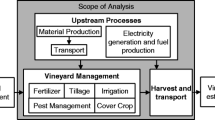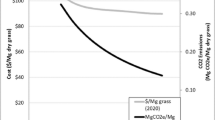Abstract
Purpose
This study provides a detailed, process-based life cycle greenhouse gas (GHG) inventory of an ornamental tree production system for urban forestry. The success of large-scale tree planting initiatives for climate protection depends on projects being net sinks for CO2 over their entire life cycle. However, previous assessments of urban tree planting initiatives have not accounted for the inputs required for tree production in nurseries, which include greenhouse systems, irrigation, and fertilization. A GHG inventory of nursery operations for tree production is a necessary step to assess the life cycle benefits or drawbacks of large-scale tree planting activities.
Methods
Using surveys, interviews, and life cycle inventory databases, we developed a process-based life cycle inventory of GHG emissions for a large nursery operation in California, USA.
Results and discussion
The inventory demonstrated that 4.6 kg of CO2-equivalent is emitted per #5 (nominally a 5-gallon) tree, a common tree size produced by nurseries. Energy use contributed 44% of all CO2-equivalent emissions, of which electricity and propane constituted 78%. Electricity use is dominated by irrigation demands, and propane is used primarily for greenhouse heating. Material inputs constituted the next largest contributor at 36% of emissions; plastic containers contributed just over half of these emissions. Transport emissions accounted for 16% of total nursery GHG emissions. Shipping bamboo stakes from China (43%) and diesel fuel consumed by nursery delivery trucks (33%) were the largest transport emission sources.
Conclusions
GHG emissions from the tree production life stage are 20% to 50% of mean annual CO2 storage rates based on urban tree inventories for three California cities. While considering nursery production alone is insufficient for drawing conclusions about the net climate change benefits of tree planting initiatives, the results demonstrate that nursery production emissions are modest compared with CO2 storage rates during tree life. Identifying key sources of emissions in the nursery tree production system can help operators reduce emissions by targeting so-called hot-spots. In particular, switching to renewable energy sources, capitalizing on energy and water efficiency opportunities, container light-weighting, and sourcing bamboo stakes from producers closer to the point of use are potential avenues for reduced emissions.


Similar content being viewed by others
References
Akbari H (2002) Shade trees reduce building energy use and CO2 emissions from power plants. Environ Pollut 116(supplement 1):S119–S126
Aldentun Y (2002) Life cycle inventory of forest seedling production—from seed to regeneration site. J Clean Prod 10(1):47–55
Berg S, Lindholm EL (2005) Energy use and environmental impacts of forest operations in Sweden. J Clean Prod 13(1):33–42
Bethke CL (2008) Nutritional properties of Agrocoir. Horticultural Soils and Nutrition Consulting for AgroCoco, Williamston
British Standards Institute (2008) PAS 2050: 2008-Specification for the assessment of the life cycle greenhouse gas emissions of goods and services. London
CAR (2010) Urban forest project protocol, v1.1. Climate Action Reserve, Los Angeles
CCAR (2009) General reporting protocol, version 3.1. California Climate Action Registry, Los Angeles
City of Los Angeles (2007) Green LA: an action plan to lead the nation in fighting global warming. City of Los Angeles, Los Angeles
Intergovernmental Panel on Climate Change (1996) Revised 1996 IPCC guidelines for national greenhouse gas inventories. Geneva, Switzerland.
Intergovernmental Panel on Climate Change (2007) Climate change 2007. The physical science basis. Contribution of Working Group I to the Fourth Assessment Report of the Intergovernmental Panel on Climate Change. Cambridge
CORRIM Inc. (2004) Phase I research report on the research plan to develop environmental-performance measures for renewable building materials with alternatives for improved performance. Seattle, WA.
Couillard S, Bage G, Trudel JS (2009) Comparative life cycle assessment of artificial vs natural christmas tree. Ellipsos, Montreal
Dwyer JF, Nowak DJ, Noble MH, Sisinni SM (2000) Assessing our nation’s urban forests: connecting people with ecosystems in the 21st century. General Technical Report. US Department of Agriculture, Forest Service, Pacific Northwest Research Station, Portland, OR.
Ecoinvent Centre (2008) Ecoinvent data v2.0. Swiss Centre for Life Cycle Assessment, Duebendorf, Switzerland
Fan J, Kalnes TN, Alward M, Klinger J, Sadehvandi A, Shonnard DR (2010) Life cycle assessment of electricity generation using fast pyrolysis bio-oil. Renew Energy 36:632–641
Heller MC, Keoleian GA, Volk TA (2003) Life cycle assessment of a willow bioenergy cropping system. Biomass Bioenerg 25(2):147–165
Hymon S, Merl J (2006) L.A. to be remade in the shade. Los Angeles Times, 1 October 2006
PE International (2009). GaBi 4 professional. Boston
Johnson LR, Lippke B, Marshall JD, Comnick J (2005) Life-cycle impacts of forest resource activities in the Pacific Northwest and Southeast United States. Wood Fiber Sci, Corrim Special Issue 37:30–46
McPherson EG (1998) Atmospheric carbon dioxide reduction by Sacramento's urban forest. J Arboric 24(4):215–223
McPherson EG, Simpson JR (1999) Carbon dioxide reductions through urban forestry: guidelines for professional and volunteer tree planters. Gen. Tech. Rep. PSW-171. Albany, CA, USDA Forest Service, Pacific Southwest Research Station
McPherson EG, Simpson JR (2002) A comparison of municipal forest benefits and costs in Modesto and Santa Monica, California, USA. Urban For Urban Green 1(2):61–74
McPherson EG, Simpson JR, Peper PJ, Maco SE, Xiao Q (2005) Municipal forest benefits and costs in five U.S. cities. J For 103(8):411–416
McPherson EG, Young R (2010) Understanding the challenges of municipal tree planting. Arborist News 19(6):60–62
McPherson EG, Simpson JR, Xiao Q, Wu C (2011) Million trees Los Angeles canopy cover and benefit assessment. Landsc Urban Plan 99(1):40–50
National Renewable Energy Laboratory (2008) U.S. life-cycle inventory database. http://www.nrel.gov/lci/database/. Accessed on: 20 June 2010
Nowak DJ, Crane DE (2002) Carbon storage and sequestration by urban trees in the USA. Environ Pollut 116(3):381–389
Nowak DJ, Stevens JC, Sissini SM, Luley CJ (2002) Effects of urban tree management and species selection on atmospheric carbon dioxide. J Arboric 28(3):113–122
Puettmann ME, Wilson JB (2005) Life-cycle analysis of wood products: cradle-to-gate LCI of residential wood building materials. Wood Fiber Sci, Corrim Special Issue 37:18–29
Russo G, Zeller BL (2008) Environmental evaluation by means fo LCA regarding the ornamental nursery production in rose and sowbread greenhouse cultivation. Acta Hort 801:1597–1604
Schwab JC (ed) (2009) Planning the urban forest: ecology, economy and community development. Planning Advisory Series Report No 555. American Planning Association, Chicago
Sloan DR, Kidder G, Jacobs RD (1996) Poultry manure as a fertilizer. University of Florida IFAS Extension. http://edis.ifas.ufl.edu/aa205. Accessed on: 18 May 2011
Sonne E (2006) Greenhouse gas emissions from forestry operations. J Environ Qual 35(4):1439–1450
van der Lugt P, van den Dobbelsteen AAJF, Janssen JJA (2006) An environmental, economic and practical assessment of bamboo as a building material for supporting structures. Constr Build Mater 20(9):648–656
Acknowledgments
The authors thank Mr. John Keller, Vice President Operations, Monrovia Nursery Company, for his interest and support of this research. We are indebted to the many other individuals and companies that provided information for the study.
Author information
Authors and Affiliations
Corresponding author
Additional information
Responsible editor: Matthias Finkbeiner
Rights and permissions
About this article
Cite this article
Kendall, A., McPherson, E.G. A life cycle greenhouse gas inventory of a tree production system. Int J Life Cycle Assess 17, 444–452 (2012). https://doi.org/10.1007/s11367-011-0339-x
Received:
Accepted:
Published:
Issue Date:
DOI: https://doi.org/10.1007/s11367-011-0339-x




